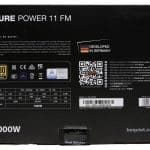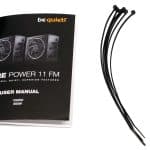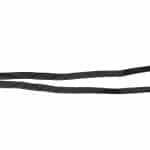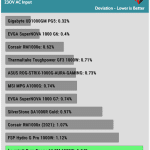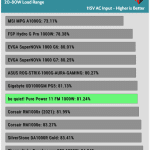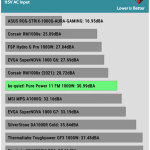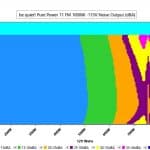The Pure Power line is above System Power in the be quiet! portfolio and below the Straight Power and Dark Power. The Pure Power 11 FM is the flagship of the line, offering good performance and decent build quality, but not so low noise output, at higher loads at least. When you hear the name “be quiet!” you expect to only find whisper quiet products under all conditions and nothing less. This doesn’t seem to be the case, though, for the Pure Power 11 FM 1000.
be quiet has several PSU lines: TFX Power, SFX Power, System Power, Pure Power, Straight Power, and Dark Power. I have already reviewed a System Power 10 unit, so it is high time to move up the chain and look at the flagship model of the next line, the Pure Power 11 FM 1000W. The Pure Power 11 series consists of three sublines, one with fixed cables, one featuring semi-modular PSUs, and the last with fully-modular members. Instead of having many PSU lines, which can confuse buyers, be quiet! chose this scheme instead, which looks better, indeed.
The Pure Power 11 FM line includes five members with capacities ranging from 550W to 1000W. They are all 80 PLUS Gold certified, utilize a fully modular cable design, and promise a quiet operation like every product of this brand. The last remains to be proved.
The be quiet! Pure Power 11 FM is Gold certified by Cybenetics and 80 PLUS. It also has a Cybenetics Standard++ noise rating, which doesn’t look so appealing for a be quiet! product. There is no semi-passive operation, which is fine with me as long as the fan spins at low speeds under light loads. The rifle fan only measures 120mm in diameter. Given the 160mm depth of the chassis, I cannot understand why they didn’t use a larger fan, which would provide the same airflow at lower speeds. Hence output noise would be lower.
- Manufacturer (OEM): HEC
- Max Power: 1000W
- Cybenetics Efficiency: [115V] Cybenetics Gold (87-89%)
- 80 Plus Efficiency: Gold
- Noise: Cybenetics Standard++ (30-35 dB[A])
- Compliance: ATX12V v2.53, EPS 2.92
- Alternative Low Power Mode support: Yes
- Power 12V: 999.6W
- Power 5V + 3.3v: 120W
- Power 5VSB: 15W
- Cooling: 120mm Rifle Bearing Fan (BQ QF2-12025-HS)
- Semi-Passive Operation: No
- Modular Design: Yes (Fully)
- High Power Connectors: 2x EPS (2x cables), 6x PCIe 6+2 pin (3x cables)
- Peripheral Connectors: 10x SATA (3x cables), 2x 4-pin Molex (single cable)
- ATX/EPS Cable Length: 550/600mm
- Distance between SATA connectors: 150mm
- Distance between 4-pin Molex connectors: 150mm
- In-cable capacitors: No
- Dimensions (W x H x D): 150 mm x 85 mm x 160 mm
- Weight: 1.89 kg (4.17 lb)
- Warranty: 5 years
Box & Bundle
The large box offers mediocre protection since only a bubble wrap protects the PSU. I would like to see packing foam used instead.
Product Photos
The design is hugely affected by the distinctive fan grille, with a whiteish accent surrounding the fan. At the face of the unit, you will find the typical stuff, the AC receptacle, and the power switch. Since there is no semi-passive mode, there is no additional switch. Around the back, ten sockets await the corresponding cables.
Cables
| Modular Cables | ||||
| Description | Cable Count | Connector Count (Total) | Gauge | In Cable Capacitors |
|---|---|---|---|---|
| ATX connector 20+4 pin (550mm) | 1 | 1 | 16-22AWG | No |
| 4+4 pin EPS12V (600mm) | 1 | 1 | 18AWG | No |
| 8 pin EPS12V (600mm) | 1 | 1 | 18AWG | No |
| 6+2 pin PCIe (500mm+150mm) | 2 | 4 | 16-18AWG | No |
| 2x 6+2 pin PCIe (500mm) | 1 | 2 | 16AWG | No |
| SATA (500mm+150mm+150mm+150mm) | 2 | 8 | 18AWG | No |
| SATA (500mm+150mm) / 4-pin Molex (+150mm+150mm) / FDD (+150mm) | 1 | 2 / 2 / 1 | 18-20AWG | No |
| AC Power Cord (1360mm) – C13 coupler | 1 | 1 | 18AWG | – |
This is a pre-ATX v3.0 PSU, so don’t expect 12VHPWR connectors. Still, you can buy the optional be quiet! 12+4 pin connector to combine this PSU with an NVIDIA 4000 series card.
I would like to see longer ATX and EPS cables, reaching 600mm and 650mm, respectively. The provided connectors are enough, and the distance between peripheral connectors is good at 150mm.
Protection Features
| OCP (Cold @ 24°C) | 12V1: 57.7A (125.46%), 12.038V 12V2: 53.3A (126.93%), 11.855V 5V: 37.7A (171.36%), 4.989V 3.3V: 34A (154.55%), 3.275V 5VSB: 5.4A (180%), 5.003V |
| OCP (Hot @ 42°C) | 12V1: 57.3A (124.57%), 12.045V 12V2: 52.7A (125.48%), 11.861V 5V: 36.8A (167.27%), 4.991V 3.3V: 33A (150%), 3.278V 5VSB: 5.4A (180%), 5.005V |
| OPP (Cold @ 23°C) | 1122.84W (112.28%) |
| OPP (Hot @ 43°C) | 1110.91W (111.09%) |
| OTP | ✓ (185°C @ 12V Heat Sink) |
| SCP | 12V to Earth: ✓ 5V to Earth: ✓ 3.3V to Earth: ✓ 5VSB to Earth: ✓ -12V to Earth: ✓ |
| PWR_OK | Proper operation |
| NLO | ✓ |
| SIP | Surge: MOV Inrush: NTC Thermistor & Bypass relay |
The are two 12V rails, and this makes my job more challenging during OCP evaluation. Both have correctly set OCP triggering points, but this is not the case for the minor rails. I keep shouting this; there is no need for such high amperage on the minor rails, especially 3.3V. If a user manages to load these rails so high for prolonged periods and under high temperatures, they could break the VRMs that generate them and thus destroy the PSU. The over-power protection is set correctly, and I would like a lower over-temperature threshold.
Part Analysis
| General Data | – |
| Manufacturer (OEM) | HEC |
| PCB Type | Double Sided |
| Primary Side | – |
| Transient Filter | 4x Y caps, 3x X caps, 2x CM chokes, 1x MOV, 1x MPS HF81 (Discharge IC) |
| Inrush Protection | NTC Thermistor SCK-056 (5 Ohm) & Relay |
| Bridge Rectifier(s) |
2x MCC GBU15L06 (800V, 15A @ 75°C)
|
| APFC MOSFETs |
3x Infineon IPA60R120P7 (600V, 16A @ 100°C, Rds(on): 0.12Ohm)
|
| APFC Boost Diode |
1x CREE C6D10065A (650V, 10A @ 155°C)
|
| Bulk Cap(s) |
2x Teapo (400V, 470uF each or 940uF, 2,000h @ 105°C, LG)
|
| Main Switchers |
2x On Semiconductor NTPF110N65S3HF (650V, 19.5A @ 100°C, Rds(on): 0.11Ohm)
|
| APFC Controller |
Champion CM6500UNX & CM03AX
|
| Resonant Controller | Champion CM6901T6X |
| Topology |
Primary side: APFC, Half-Bridge & LLC converter
Secondary side: Synchronous Rectification & DC-DC converters |
| Secondary Side | – |
| +12V MOSFETs | 6x On Semiconductor NTMFS5H400NL (40V, 210A @ 100°C, Rds(on): 0.8mOhm) |
| 5V & 3.3V | DC-DC Converters |
| Filtering Capacitors | Electrolytic: 14x Teapo (1-3,000 @ 105°C, SC) Polymer: 6x Teapo, 6x Elite, 16x no info |
| Supervisor IC | Weltrend WT7527RT (OCP, OVP, UVP, SCP, PG) |
| Fan Model | be quiet! BQ QF2-12025-HS (120mm, 12V, 0.30A, Rifle Bearing Fan) |
| 5VSB Circuit | – |
| Rectifier |
1x PS1060L SBR (42V, 10A)
|
| Standby PWM Controller | Excelliance MOS EM8569D |
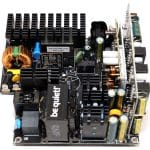




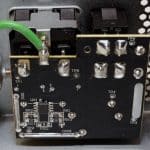

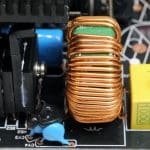



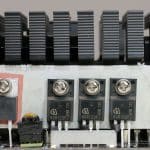
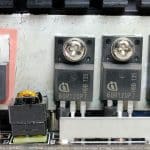















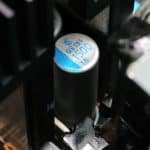





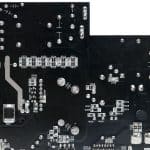



This modern platform by HEC uses decent parts to do the job without breaking the bank. I don’t have a problem with the Teapo bulk caps, but I would feel more confident if be quiet! used better filtering caps on the secondary side. To give you an idea of what I am talking about, the Corsair RM1000x (2021) uses nine Nippon Chemi-Con (4-10,000h @ 105°C, KY) filtering caps and the rest caps are of similar quality, while this be quiet! unit uses 14x Teapo SC caps which only have a 1-3,000h lifetime, depending on their size. The difference in durability is notable. That said, the Pure Power 11 FM 1000 went for 160 dollars, while the RM1000x had a $190 price tag at the time of the review. The 30-dollar difference is considerable.
On the other hand, the Corsair RM1000e currently costs 10 dollars less than the be quiet! unit, so I would choose this model as its direct opponent. The RM1000e model also uses a similar spec but with a different design HEC platform, which uses several Teapo SC caps and includes some higher-quality ones on its secondary side. You will find the full report of the Corsair RM1000e in the Cybenetics database, including its part analysis.
Load Regulation
Load regulation should be within 1% at 12V, as it is on the minor rails (5V and 3.3V).
Ripple Suppression
Ripple suppression is good.
Transient Response
The Corsair RM1000x, one of the best-performing 1000W units, is out of reach for the Pure Power FM 1000. The RM1000e performs better at 12V, the most critical rail, while losing on the minor rails. I would like to see the 12V rail’s transient response closer to 1% and a tighter response at 5V.
Hold Up Time
The hold-up time is longer, and the power ok signal is accurate. It would be nice if the latter reached or was longer than 16ms to be in line with what the ATX spec requires.
Timings
The PSU supports Alternative Low Power Modes.
Inrush Current
Inrush current is low at 115V but sky-high at 230v.
Efficiency Normal, Light & Super-Light Loads
This HEC platform achieves satisfactory efficiency on all load ranges.
Average Efficiency 5VSB
The 5VSB rail is highly efficient.
Vampire Power
Vampire power is low with 115V, and it could be lower with 230V input.
Average Efficiency
The average efficiency is decent for a Gold unit.
Average PF
The APFC converter desperately needs tuning for higher PF readings.
Average Noise
You cannot call this PSU noisy, but I expected more in this section by a be quiet! product. The RM1000e wins easily here, with a 5.1 dBA difference in average noise output.
Fan Noise & Speed Maps @ 28-32 °C
With up to 490W, you won’t hear the fan’s unit spinning. The 30 dBA mark is passed with 700W, and with 810W and higher loads, the PSU is noisy, exceeding 40 dBA. The fan speed profile at high loads affects the overall noise output. You won’t notice the fan’s noise at light and moderate loads.
Overall Performance
The overall performance puts the Pure Power FM 11 1000 above the Corsair RM1000e, which is its primary opponent, given the price tags of these two units.
Epilogue
be quiet! developed a new platform with HEC, which delivers satisfactory results. The Pure Power 11 FM takes a slight lead from its direct opponent, the Corsair RM1000e, which also uses a platform by HEC, but the latter achieves higher efficiency, better PF readings, and, above all, lower noise output. I expect from a be quiet! product to be as quiet as it gets and not lose notably by its significant opponents, which is the case here. This brand built its reputation on silent operating products, so it has to carry this tradition.
The Pure Power 11 FM is a decent product, which should have a lower price if you ask me, to be more competitive, especially in the demanding US market. The RM1000e costs ten dollars less at the time of the review, and it is covered by a longer warranty (7 years vs. 5 years). If you combine all the above, you will quickly realize there is no point in preferring the more expensive Pure Power 11 FM instead of the Corsair RM1000e unless you cannot find the latter in stock.
If anyone from be quiet! reads this review, you should do the following to improve the Pure Power 11 FM 1000.
- Make this unit ATX v3.0 and PCIe 5.0 ready
- Decrease average noise output
- Tighten a bit load regulation and the transient response at 12V
- Lower inrush current with 230V input
- Tune the APFC converter to provide higher readings
Buy be quiet! Pure Power 11 FM 1000W
- Full power at 47°C
- High enough overall performance
- Efficient
- Highly efficient 5VSB rail
- Properly set OCP at 12V and OPP
- Quiet operation under light and moderate loads
- Good ripple suppression
- Longer than 17ms hold-up time
- Low inrush current with 115VAC
- ALPM support
- Option for 12VHPWR connector
- Fully modular
- Adequate distance between the peripheral connectors
- Good soldering quality
- 5-year warranty
- The average noise output should be below 30 dBA
- Low-performance APFC converter
- Its price tag needs to get lower
- High OCP on the minor rails
- Transient response and load regulation at 12V should be better
- High inrush current with 230V




